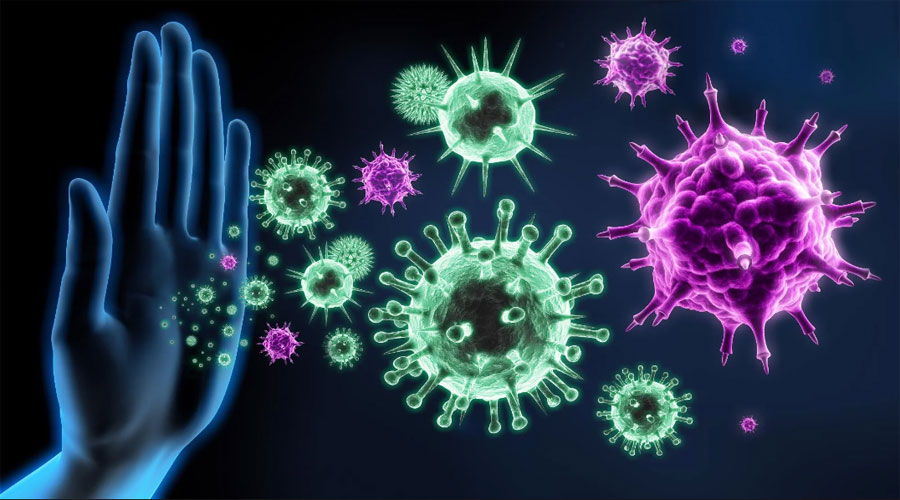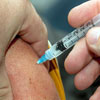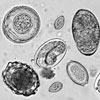The Immune System

[Image Credit: Shutterstock]
by Ross Horne
The immune system is the name given to the complex organization of glands, white cells (leucocytes), antibodies, and other protein substances, hormones, enzymes and bacteria which protect the body against potentially harmful germs, viruses and foreign substances which may gain access to it. Such intruders, inert or alive, are called antigens.
An antigen may be any germ or virus, undigested protein, mineral particle or poisonous substance. Apart from antigens, a challenge to the body’s well-being such as trauma of any kind, or stress — physical or emotional — will stimulate the immune system, whereupon standby white cells are released into the circulation. Even brief bursts of physical activity have the effect of increasing the white blood cell count.
Apart from maintaining a constant state of warfare against intruders, the immune system as a normal activity will destroy cells of its own body if they become defective and no longer of any use. Red cells of the blood wear out after a period variously estimated at from six to seventeen weeks and are continually being replaced, and it is the ordinary job of the white cells to destroy the red cells as they become defective. Millions are destroyed and replaced every minute. In a similar fashion, if normal body cells become cancerous or virus infected, the immune system when working properly, will recognize they are defective and destroy them too.
White cells are called leucocytes. There are many kinds of leucocytes, mobile living cells which originate in the bone marrow and migrate to inhabit every tissue and fluid of the body in great numbers. Some are very mobile, able to proceed quickly in the body fluids to wherever they may be needed, and some remain more or less stationary in the tissues. They work in different ways, cooperating together to destroy anything dangerous or potentially dangerous.
Phagocytes are white cells which destroy antigens by consuming and digesting them. Large phagocytes called macrophages consume defective body cells as well as antigens from outside the body. Neutrophils are the most numerous of the mobile phagocytes and are primarily concerned in the defense against invading germs or viruses.
Patrolling constantly in the blood and lymph fluid are the lymphocytes, of which there are two main types, B lymphocytes and T lymphocytes. The prime function of B cells is to provide specific immune action against specific antigens, in other words to give any single antigen “individualized attention”. B cells do this by manufacturing specific antibodies, protein substances capable of immobilizing an antigen or marking it ready for destruction by other white cells. Designed only for the one specific antigen, for instance a certain strain of virus, those particular antibodies will act only against that virus and against no other. Thus the B cells, as and when a new antigen appears, will manufacture a specific antibody for it alone. Depending upon the degree of attack and rate of proliferation by an invading organism, the B cells themselves multiply rapidly and increase the production of antibodies to meet the challenge. When an invader has been destroyed, the cell population returns to normal, and some of the antibodies are retained in case of another encounter, in which case the antigen will be dispatched before it can get started. Thus the body is immune to that specific antigen thereafter. This is called specific immunity.
T lymphocytes are cells which have matured in the thymus and perform differently to B lymphocytes. T cells are mainly involved in the elimination of various defective body cells which are known as target cells. As with antibodies, different T cells are specific to react against specific antigens, and when necessary will proliferate in great numbers of the particular T cell type required. T cells are extremely complex and from them develop other special cells — killer cells, helper cells and suppressor cells. Killer cells destroy target cells by puncturing them or injecting them with lymphotoxin, and helper cells assist in the production of antibodies by the B cells. Suppressor cells act in the opposite fashion to helper cells and monitor the proceedings to reduce activity as required.
Not all lymphocytes circulate in the lymph and blood. The majority of them remain in reserve in the many nodes and glands of the lymphatic system, as well as the thymus, spleen and numerous other locations such as the tonsils and appendix.
Natural killer cells are cells unrelated to other white cells except for their origin in the bone marrow, and function independently and non-specifically to attack and destroy target cells of any kind.
Thus there are two kinds of immune response by the body: the general response against all antigens, and the specific response against each individual antigen, with the specific system providing ongoing immunity against the recurrence of the numerous antigens encountered one by one throughout life.
Inflammation and fever are yet another function of the immune response and may occur locally at an area of infection or as the increased temperature of the entire body. Enzyme activity is greatest at fever temperatures, increasing the metabolic rate of the body 50% at 41°C (106°F) and so the fever which accompanies acute infection is an indication of good immune response.
Often accompanying infection is swelling and soreness of the lymph glands nearest the seat of infection, indicating that the infecting agent has been arrested from spreading past that point. Pus and mucus are the remains of destroyed tissue, dead germs and white cells at the site of an infection.
Without the protection of the immune system, death from any number of infections would be swift and certain. At the beginning of life, when a baby’s immune system is still being developed, immune protection is provided by substances in the mother’s milk, which is one of many reasons a baby should be breast-fed.
Because in the first year of life the immune system and the digestive system are still developing, the feeding of certain foods such as cereals, eggs, pasteurized milk, etc., to a baby may cause permanent allergies. This is because undigested food particles which enter the bloodstream confuse the developing immune system which accepts them as normal in the body. Thus, in later life, should poor digestion again permit the entry of undigested particles of the same food substances into the bloodstream, instead of being digested by enzymes and white cells, the substances may be ignored by the immune system and circulate to cause allergic reactions.
As life progresses, people encounter various infections one by one and develop immunity to each of them.
The capability of the immune system depends upon the general state of health and physical fitness, but regardless of this, immunocompetence may be drastically reduced in a healthy body by fatigue or excessive stress.
The condition of the bloodstream is very important. When toxemia exists, and fat in the blood sticks red cells and platelets together increasing blood viscosity and decreasing oxygen levels, nothing can work properly — the white cells, the thymus and other vital organs, nor any other component of the immune system. Improvement in blood condition rapidly restores the immune function, and it is significant that patients who adopt a properly constituted diet soon notice they no longer “catch” head colds. The dietary substances most inhibitory to the immune system are fat, cholesterol and excess protein, all of which are commonly consumed in excessive quantities.
Various chronic diseases and the diminished vitality accompanying them are invariably marked by low body temperature, low enzyme levels, and low immunocompetence. Thus senile and chronically ill people succumb more readily to acute infection.
In particular, the level of immunocompetence depends on a healthy thymus, which in concert with the other endocrine glands, directs the immune system “orchestra”. As health fails or excessive demand is made on the immune system by way of infection or trauma of any kind, the production of thymus hormones decreases and the thymus becomes exhausted and shrinks in size. Other depressants of the immune system are drugs, such as nicotine, alcohol, tranquilizers, antibiotics, painkillers, aspirin, etc., and various chemicals such as fluoride and chlorine which are widely used added to city water supplies.
Vitamin C is important for the proper function of the immune system, and the generally inadequate intake of this vitamin in civilized populations is one reason for the low standard of immunocompetence displayed by most people. In the presence of stress or any of the depressants mentioned, the requirement for Vitamin C is increased enormously.
Because of the generally poor standard of immunocompetence in modern society, the antibiotic drugs, so effective at killing germs, have assumed enormous importance in medicine, but whereas a healthy immune system eliminates germs and viruses with equal dispatch, antibiotics have no effect at all on viruses, which is why herpes and the common cold cannot be “cured”. It has become apparent in recent years that the indiscriminate use of antibiotics is damaging to the immune system to the extent of being one of the major factors in AIDS.
Immunization
Among their many unique qualities as intelligent beings, humans possess ego, sometimes in amazing amounts. It is written in the bible that God created man in his own image, and many men not only accept this but at the same time fancy they possess God’s wisdom as well. With little thought of the future, man presumptuously meddles with Nature, and in the last hundred years or so has already almost destroyed planet Earth.
In the field of medicine, man zealously “improves” on Nature in many bizarre ways. Immunization is one of them. With the simple confidence of a child poking at the innards of a color television set with a screwdriver, doctors, with the best of intentions presume to improve upon Nature’s masterpiece, the immune system.
The dramatic demonstration of immunization of animals against various microbes over a hundred years ago by Louis Pasteur impressed the majority of the world’s leading doctors so much that the germ theory of disease, previously ridiculed, became generally accepted overnight and since then has dominated medical thought. Although Pasteur himself, not long before he died, realized the basic error of the germ theory, it was too late — the theory was established, set like concrete for a hundred years.
The theory sounded good, and it was believed that when eventually a vaccine had been found for every disease, humans could become disease-free thereafter. The dream never eventuated, but the advent of the “wonder drugs” like penicillin and antibiotics appeared for a while to provide the missing answers and most people continued to believe that the key to health lay in the destruction of germs and viruses. The idea of medical immunization is to artificially provide specific immunity against different disease microbes by injecting a vaccine made from the microbe, rendered harmless, but still capable of exciting sufficient specific response to produce enough antibodies to provide immunity.
This, of course, does happen, but at the same time very often complications occur which may be very dangerous. It is evident that over the years more suffering and deaths have eventuated from immunization than would have occurred without it.
Since Edward Jenner of England in 1796 demonstrated the use of cowpox vaccine against smallpox, vaccinations against smallpox were started. Despite this, a smallpox epidemic swept England in 1839 and killed 22,081 people. The Government in 1853 made smallpox vaccinations compulsory, but the incidence of the disease kept increasing, and in 1872 another epidemic killed 44,840 people, most of whom were vaccinated. The compulsory vaccination law was abolished in 1948. Similar disasters occurred in Germany and Japan but possibly the worst was in the Philippines in 1918 when the US Government forced over three million natives to be vaccinated. Of these, 47,369 came down with smallpox and 16,477 died. In 1919 the program was doubled, and over seven million were vaccinated, of whom 65,180 came down with the disease, and 44,408 died. The epidemic was a direct result of the vaccination program. These facts are described by Dr. William F. Koch in his book, The Survival Factor in Neoplastic and Viral Disease (1961). Dr. Koch further described the disastrous increase in polio incidence in the USA and Canada following the mass inoculation campaign against polio in 1958. The highest increase was 700% in Ottawa, Canada. Dr. Robert Mendelsohn in his book, Confessions of a Medical Heretic, questions the safety of all immunizations, including diphtheria and whooping cough, in a chapter titled, “If this is Preventive medicine, I’ll take my chances with Disease!”.
Immunotherapy
Immunotherapy is attempting to influence the course of a disease by artificial manipulation of the immune system after the disease has become established. Vaccines made from blood samples, urine, etc., have been used against a number of diseases in an endeavor to stimulate a specific immune response, as well as various other vaccines designed to stimulate the nonspecific response. Results have always been disappointing, and this is no wonder.
Failure of immunotherapy is inevitable, because it is designed to stimulate artificially something which is exhausted. The solution is simple — forget about the immune system, forget about the tumor, headache, or what-have-you, and set about to restore the general health with diet, rest, relaxation, sunshine and exercise. The immune system will thereupon regenerate along with the rest of the body, thankful to be free of medical “help”.
Excerpt from The Health Revolution
Posted in Health, Other Topicswith comments disabled.





